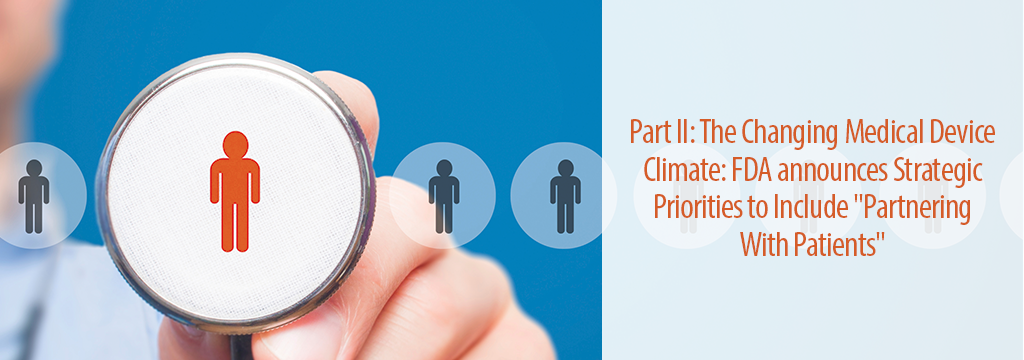As a result of a system that is in need of revamping, the FDA’s Center for Devices and Radiological Health announced its 2016 – 2017 Strategic Priorities that included a section titled “Partnering with Patients.”(1)
“We believe that if CDRH is to successfully achieve a mission and vision in the service of patients, we must interact with patients as partners and work together to advance the development and evaluation of innovative devices, and monitor the performance of marketed devices.” – CDRH
Furthermore, in the Strategic Priorities document it states “It’s no coincidence that our vision begins with “patients.” Patients are at the heart of everything we do. Patients are no longer passive bystanders in their health. They actively seek information and engage in disease management and shared decision-making with their health care practitioners. We value their perspectives and our engagement with them improves our understanding of the patient experience. However, we can and should do more. We believe that if CDRH is to successfully achieve a mission and vision in the service of patients, we must interact with patients as partners and work together to advance the development and evaluation of innovative devices, and monitor the performance of marketed devices. We also understand that many patients such as children have family caregivers who are also our customers and we are committed to engaging them to achieve this mission. This priority reflects and builds on our strong commitment to patients as our most important customers. The time to take this critical step forward is now.”
The document outlines a series of goals and actions.
GOAL: PROMOTE A CULTURE OF MEANINGFUL PATIENT ENGAGEMENT BY FACILITATING CDRH INTERACTION WITH PATIENTS
- By December 31, 2016, establish one or more new mechanisms for CDRH employees to obtain patient input on key pre- and post market issues facing CDRH and foster participation of 10 patient groups to participate.
- By December 31, 2017, foster participation of 20 patient groups to participate in these mechanisms.
- By December 31, 2016, 50 percent of CDRH employees will interact with patients as part of their job duties.
- By December 31, 2017, 90 percent of CDRH employees will interact with patients as part of their job duties.
GOAL: INCREASE USE AND TRANSPARENCY OF PATIENT INPUT AS EVIDENCE IN OUR DECISION MAKING
- By September 30, 2016, 50 percent of PMA, de novo and HDE decisions will include a public summary of available and relevant patient perspective data considered.
- By September 30, 2017, 100 percent of PMA, de novo and HDE decisions will include a public summary of available and relevant patient perspective data considered.
- By September 30, 2017, increase the number of patient perspective studies (e.g., evaluating patient reported outcomes or patient preferences) used in support of premarket and postmarket regulatory decisions. (compared to FY 2015 baseline)
- By September 30, 2017, increase the number of Expedited Access Pathway data development plans or regulatory submissions that consider patient perspectives. (Compared to FY 2015 baseline)
How will this increased patient engagement affect the changing landscape? Enterprise success depends on the capability to perform research, develop new products and services, and adapt them to meet the changing needs of consumers. Quality is a fundamental factor in enterprise success because, in addition to low cost points, patients require high quality products. Prior to the 1990s, most enterprises expected quality improvements would result in cost increases and a decline in profitability. For contemporary enterprises catering to more sophisticated customers with evolving needs and operating amongst strong competition of global markets, quality becomes paramount in order to remain competitive. Not only is product quality essential for success, but the quality and effectiveness of all the business processes matter as well. It means “quality systems is a set of management activities which improve organizational efficiency, increase productivity, reduce costs and improve competitive positioning.”
“Optimizing Product Realization” recognizes the co-dependencies between Quality and Business Performance. At EngiLifeSciences, we take a strategic perspective that recognizes the end-to-end value chain must be properly aligned to deliver on customer and shareholder expectations. Quality cannot be separated from the final product, it must continually be considered in all enterprise activities. (2)




